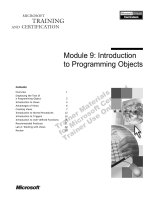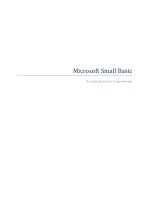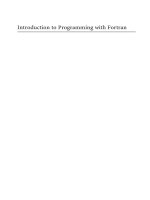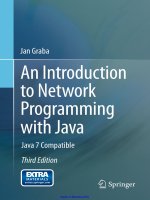Introduction to Cplusplus programming
Bạn đang xem bản rút gọn của tài liệu. Xem và tải ngay bản đầy đủ của tài liệu tại đây (203.25 KB, 30 trang )
2003 Prentice Hall, Inc. All rights reserved.
1
Introduction to C++ Programming
Outline
History of C and C++
C++ Standard Library
Object Technology
Basics of a Typical C++ Environment
General Notes About C++ and This Book
Introduction to C++ Programming
A Simple Program: Printing a Line of Text
Another Simple Program: Adding Two Integers
Arithmetic
Decision Making: Equality and Relational Operators
Thinking About Objects: Introduction to Object Technology
2003 Prentice Hall, Inc. All rights reserved.
2
History of C and C++
•
History of C
–
Evolved from two other programming languages
•
BCPL and B
–
“Typeless” languages
–
Dennis Ritchie (Bell Laboratories)
•
Added data typing, other features
–
Development language of UNIX
–
Hardware independent
•
Portable programs
–
1989: ANSI standard
–
1990: ANSI and ISO standard published
•
ANSI/ISO 9899: 1990
2003 Prentice Hall, Inc. All rights reserved.
3
History of C and C++
•
History of C++
–
Extension of C
–
Early 1980s: Bjarne Stroustrup (Bell Laboratories)
–
“Spruces up” C
–
Provides capabilities for object-oriented programming
•
Objects: reusable software components
–
Model items in real world
•
Object-oriented programs
–
Easy to understand, correct and modify
–
Hybrid language
•
C-like style
•
Object-oriented style
•
Both
2003 Prentice Hall, Inc. All rights reserved.
4
C++ Standard Library
•
C++ programs
–
Built from pieces called classes and functions
•
C++ standard library
–
Rich collections of existing classes and functions
•
“Building block approach” to creating programs
–
“Software reuse”
2003 Prentice Hall, Inc. All rights reserved.
5
Object Technology
•
Objects
–
Reusable software components that model real world items
–
Meaningful software units
•
Date objects, time objects, paycheck objects, invoice objects,
audio objects, video objects, file objects, record objects, etc.
•
Any noun can be represented as an object
–
More understandable, better organized and easier to maintain
than procedural programming
–
Favor modularity
•
Software reuse
–
Libraries
•
MFC (Microsoft Foundation Classes)
•
Rogue Wave
2003 Prentice Hall, Inc. All rights reserved.
6
Basics of a Typical C++ Environment
•
C++ systems
–
Program-development environment
–
Language
–
C++ Standard Library
2003 Prentice Hall, Inc. All rights reserved.
7
Basics of a Typical C++ Environment
Phases of C++ Programs:
1. Edit
2. Preprocess
3. Compile
4. Link
5. Load
6. Execute
Loader
Primary
Memory
Program is created in
the editor and stored
on disk.
Preprocessor program
processes the code.
Loader puts program
in memory.
CPU takes each
instruction and
executes it, possibly
storing new data
values as the program
executes.
Compiler
Compiler creates
object code and stores
it on disk.
Linker links the object
code with the libraries,
creates a.out and
stores it on disk
Editor
Preprocessor
Linker
CPU
Primary
Memory
.
.
.
.
.
.
.
.
.
.
.
.
Disk
Disk
Disk
Disk
Disk
2003 Prentice Hall, Inc. All rights reserved.
8
Basics of a Typical C++ Environment
•
Input/output
–
cin
•
Standard input stream
•
Normally keyboard
–
cout
•
Standard output stream
•
Normally computer screen
–
cerr
•
Standard error stream
•
Display error messages
2003 Prentice Hall, Inc. All rights reserved.
9
General Notes About C++
and This Book
•
Book geared toward novice programmers
–
Stress programming clarity
–
C and C++ are portable languages
•
Portability
–
C and C++ programs can run on many different computers
•
Compatibility
–
Many features of current versions of C++ not compatible
with older implementations
2003 Prentice Hall, Inc. All rights reserved.
10
Introduction to C++ Programming
•
C++ language
–
Facilitates structured and disciplined approach to computer
program design
•
Structured programming
•
Object-oriented programming
2003 Prentice Hall, Inc. All rights reserved.
11
A Simple Program:
Printing a Line of Text
•
Comments
–
Document programs
–
Improve program readability
–
Ignored by compiler
–
Single-line comment
•
Begin with //
•
Preprocessor directives
–
Processed by preprocessor before compiling
–
Begin with #
2003 Prentice Hall, Inc.
All rights reserved.
Outline
12
fig01_02.cpp
(1 of 1)
fig01_02.cpp
output (1 of 1)
1 // Fig. 1.2: fig01_02.cpp
2 // A first program in C++.
3 #include <iostream>
4
5 // function main begins program execution
6 int main()
7 {
8 std::cout << "Welcome to C++!\n";
9
10 return 0; // indicate that program ended successfully
11
12 } // end function main
Welcome to C++!
Single-line comments.
Preprocessor directive to
include input/output stream
header file <iostream>.
Function main appears
exactly once in every C++
program
Function main returns an
integer value.
Left brace { begins function
body.
Corresponding right brace }
ends function body.
Statements end with a
semicolon ;.
Name cout belongs to
namespace std.
Stream insertion operator.
Keyword return is one of
several means to exit
function; value 0 indicates
program terminated
successfully.
2003 Prentice Hall, Inc. All rights reserved.
13
A Simple Program:
Printing a Line of Text
•
Standard output stream object
–
std::cout
–
“Connected” to screen
–
<<
•
Stream insertion operator
•
Value to right (right operand) inserted into output stream
•
Namespace
–
std:: specifies using name that belongs to “namespace”
std
–
std:: removed through use of using statements
•
Escape characters
–
\
–
Indicates “special” character output
2003 Prentice Hall, Inc. All rights reserved.
14
A Simple Program:
Printing a Line of Text
Escape Sequence Description
\n
Newline. Position the screen cursor to the
beginning of the next line.
\t
Horizontal tab. Move the screen cursor to the next
tab stop.
\r
Carriage return. Position the screen cursor to the
beginning of the current line; do not advance to the
next line.
\a
Alert. Sound the system bell.
\\
Backslash. Used to print a backslash character.
\"
Double quote. Used to print a double quote
character.
2003 Prentice Hall, Inc.
All rights reserved.
Outline
15
fig01_04.cpp
(1 of 1)
fig01_04.cpp
output (1 of 1)
1 // Fig. 1.4: fig01_04.cpp
2 // Printing a line with multiple statements.
3 #include <iostream>
4
5 // function main begins program execution
6 int main()
7 {
8 std::cout << "Welcome ";
9 std::cout << "to C++!\n";
10
11 return 0; // indicate that program ended successfully
12
13 } // end function main
Welcome to C++!
Multiple stream insertion
statements produce one line of
output.
2003 Prentice Hall, Inc.
All rights reserved.
Outline
16
fig01_05.cpp
(1 of 1)
fig01_05.cpp
output (1 of 1)
1 // Fig. 1.5: fig01_05.cpp
2 // Printing multiple lines with a single statement
3 #include <iostream>
4
5 // function main begins program execution
6 int main()
7 {
8 std::cout << "Welcome\nto\n\nC++!\n";
9
10 return 0; // indicate that program ended successfully
11
12 } // end function main
Welcome
to
C++!
Using newline characters to
print on multiple lines.
2003 Prentice Hall, Inc. All rights reserved.
17
Another Simple Program:
Adding Two Integers
•
Variables
–
Location in memory where value can be stored
–
Common data types
•
int - integer numbers
•
char - characters
•
double - floating point numbers
–
Declare variables with name and data type before use
int integer1;
int integer2;
int sum;
–
Can declare several variables of same type in one declaration
•
Comma-separated list
int integer1, integer2, sum;
2003 Prentice Hall, Inc. All rights reserved.
18
Another Simple Program:
Adding Two Integers
•
Variables
–
Variable names
•
Valid identifier
–
Series of characters (letters, digits, underscores)
–
Cannot begin with digit
–
Case sensitive
2003 Prentice Hall, Inc. All rights reserved.
19
Another Simple Program:
Adding Two Integers
•
Input stream object
–
>> (stream extraction operator)
•
Used with std::cin
•
Waits for user to input value, then press Enter (Return) key
•
Stores value in variable to right of operator
–
Converts value to variable data type
•
= (assignment operator)
–
Assigns value to variable
–
Binary operator (two operands)
–
Example:
sum = variable1 + variable2;
2003 Prentice Hall, Inc.
All rights reserved.
Outline
20
fig01_06.cpp
(1 of 1)
1 // Fig. 1.6: fig01_06.cpp
2 // Addition program.
3 #include <iostream>
4
5 // function main begins program execution
6 int main()
7 {
8 int integer1; // first number to be input by user
9 int integer2; // second number to be input by user
10 int sum; // variable in which sum will be stored
11
12 std::cout << "Enter first integer\n"; // prompt
13 std::cin >> integer1; // read an integer
14
15 std::cout << "Enter second integer\n"; // prompt
16 std::cin >> integer2; // read an integer
17
18 sum = integer1 + integer2; // assign result to sum
19
20 std::cout << "Sum is " << sum << std::endl; // print sum
21
22 return 0; // indicate that program ended successfully
23
24 } // end function main
Declare integer variables.
Use stream extraction
operator with standard input
stream to obtain user input.
Stream manipulator
std::endl outputs a
newline, then “flushes output
buffer.”
Concatenating, chaining or
cascading stream insertion
operations.
Calculations can be performed in output statements: alternative for
lines 18 and 20:
std::cout << "Sum is " << integer1 + integer2 << std::endl;
2003 Prentice Hall, Inc.
All rights reserved.
Outline
21
fig01_06.cpp
output (1 of 1)
Enter first integer
45
Enter second integer
72
Sum is 117
2003 Prentice Hall, Inc. All rights reserved.
22
Arithmetic
•
Arithmetic calculations
–
*
•
Multiplication
–
/
•
Division
•
Integer division truncates remainder
–
7 / 5 evaluates to 1
–
%
•
Modulus operator returns remainder
–
7 % 5 evaluates to 2
2003 Prentice Hall, Inc. All rights reserved.
23
Arithmetic
•
Rules of operator precedence
–
Operators in parentheses evaluated first
•
Nested/embedded parentheses
–
Operators in innermost pair first
–
Multiplication, division, modulus applied next
•
Operators applied from left to right
–
Addition, subtraction applied last
•
Operators applied from left to right
Operator(s) Operation(s) Order of evaluation (precedence)
()
Parentheses Evaluated first. If the parentheses are nested, the
expression in the innermost pair is evaluated first. If
there are several pairs of parentheses “on the same level”
(i.e., not nested), they are evaluated left to right.
*
,
/
,
or
%
Multiplication Division
Modulus
Evaluated second. If there are several, they re
evaluated left to right.
+
or
-
Addition
Subtraction
Evaluated last. If there are several, they are
evaluated left to right.
2003 Prentice Hall, Inc. All rights reserved.
24
Decision Making: Equality and Relational
Operators
•
if structure
–
Make decision based on truth or falsity of condition
•
If condition met, body executed
•
Else, body not executed
•
Equality and relational operators
–
Equality operators
•
Same level of precedence
–
Relational operators
•
Same level of precedence
–
Associate left to right
2003 Prentice Hall, Inc. All rights reserved.
25
Decision Making: Equality and Relational
Operators
Sta nd a rd a lgeb ra ic
equa lity op era tor or
rela tiona l op era tor
C++ equa lity
or relationa l
opera tor
Exa mp le
of C++
c ond ition
Mea ning of
C++ c ond ition
Relational operators
>
> x > y x
is greater than
y
<
< x < y x
is less than
y
≥
>= x >= y x
is greater than or equal to
y
≤
<= x <= y x
is less than or equal to
y
Equality operators
=
== x == y x
is equal to
y
≠
!= x != y x
is not equal to
y









